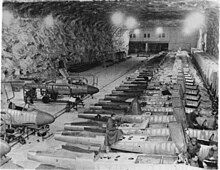
The "second Ruhr" was a World War II area that included the "southern regions of Germany, the plateau of Bohemia, and Silesia" where Nazi Germany military production was dispersed away from Allied bomber bases in England. After Allied Operation Pointblank bombing of German aircraft facilities had begun, Nazi Germany dispersed the 27 larger aircraft works across 729 medium and very small plants (some in tunnels, caves, and mines), and oil production was also dispersed (e.g., Blechhammer). However, by October 1943, long-range bombers could reach the area (e.g., Marienburg).
References
- ^ "The Coming Phase". Flight Magazine. September 23, 1943. Retrieved 2010-10-20.
This vast industrial area, which has been called by the Germans the "second Ruhr" (and which includes the Southern regions of Germany, the plateau of Bohemia, and Polish Silesia, hitherto more or less impervious to bomber attack), has been stripped of its geographic defenses
{{cite journal}}: Cite journal requires|journal=(help) - Galland, Adolf (1968) . The First and the Last: The Rise and Fall of the German Fighter Forces, 1938-1945. Ninth Printing - paperbound. New York: Ballantine Books. p. 237.
This German World War II article is a stub. You can help Misplaced Pages by expanding it. |